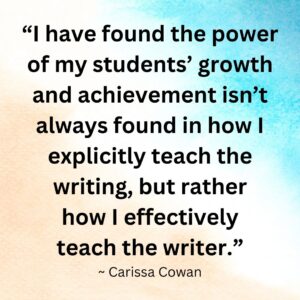Every day, every week, every month, every year…I heard the same statements. Over and over again.
“Mrs. Cowan, will you please read my writing?”
“Mrs. Cowan, can I share my writing with you?”
“Mrs. Cowan, can I read you my story?”
I really wanted to read ALL the stories. I really wanted to let EVERY child share their writing. I wanted to have the time for EACH student to read their writing to me. I wanted it ALL…but I couldn’t find the time or space in my writing block.
Until, I was introduced to authentic conferring structures where I learned what it means to truly teach the writer. Now, don’t get me wrong. I still teach the three main types of writing; informational, opinion, and narrative. I still provide lessons around how to write specific types of writing. I provide skills based lessons. But, I have found the power of my students’ growth and achievement isn’t always found in how I explicitly teach the writing, but rather how I effectively teach the writer. Every one of our student’s is so different, and what they need in their writing isn’t one size fits all. Each student needs something different, so it’s our job to find what they need and teach them that.

As I mentioned above, I wanted them to share, to read, and get concrete, specific, and tangible feedback that they could apply to their own writing. I really wanted this.
I began using my writer’s workshop time to truly confer, rather than “waitress” for my students. Previously, I’d been walking around and checking in, seeing how students were doing, and giving minimal (very minimal) feedback…but I wasn’t really seeing the depth of their writing, I wasn’t setting goals, I wasn’t using mentor texts, and I definitely wasn’t teaching them anything specific to enhance their writing skills. I wanted to change my game plan as a teacher.
How did things change?
I started an excel spreadsheet with every student’s name on a new tab and I set a goal to meet with every student each week. My goal was to meet with 5 students each day, for a total of 5-7 minutes each student. I took anecdotal notes at every conference, using them to guide future conferences and identify which teaching points they needed to grow as a writer. My goal was to truly know who each student was a writer, and teach them what they need to get better.
Every conference started with the same question: How are you growing yourself as a writer? I then asked my students to share with me what they were working on (YAY, every student was getting to share their writing with me every week, and they were so excited; and I was too). I felt like we were finally getting somewhere. As they shared their writing, I listened and looked for teaching points (see some ideas below) that could guide our conference and picked one, yes, just one (remember…I wanted to give them a concrete, specific, and tangible strategy they could try out and use in their own writing). I pulled out my own mentor texts, my own writings, and showed them where I had used this one technique in my own writing. I shared my thinking and process about how I made my own writing decisions. Lastly, we went back to their own writing and found spots where they could try out this technique. We orally rehearsed (practiced what they were going to write aloud) and we envisioned (discussed the purpose, context, and impact) together of making these revisions. Off I went to my next conference, and they were left to try this technique in their own writing.

“Teaching the Writer”->Possible Teaching Points for Writing Types:
This was a game changer for my writing instruction. This simple shift in my own process of meeting the needs of my students provided some simple solutions to one of my biggest problems.
-I was getting to see what my students were writing weekly at a deep level, and they were getting to share with me.
-I was teaching the writer, differentiating instruction…giving students one technique that they could use to enhance their own writing.
-I was giving clear, concise feedback to my students to guide and grow their growth in writing.
By teaching the writer, the game was changed.
*Sidenote: Your student might have multiple teaching points that need to be addressed. That’s okay, but take note of these and use them to guide your future conferences. In the moment, make the decision to teach the one you think will help your student the most. Basically, what’s the biggest bang for your buck and/or what technique will transcend genre/type of writing. Trust your teacher’s intuition, and what you know about your writer.



